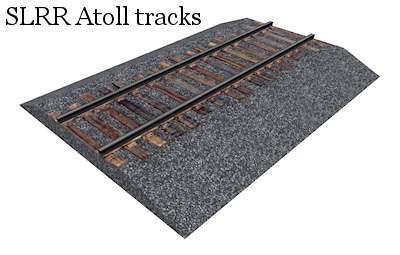Difference between revisions of "Second Life Railroad/SLRR standards"
m (→Source) |
|||
| Line 130: | Line 130: | ||
The above information was collected by the Second Life Railway Consortium (SLRC) {{SLURL2|http://slurl.com/secondlife/Tuliptree/107/131/30}} with the help of {{User2|Stryker Jenkins}}, {{User2|Moundsa Mayo}}. {{User2|Qie Niangao}} and {{User2|Kitto Flora}}. | The above information was collected by the Second Life Railway Consortium (SLRC) {{SLURL2|http://slurl.com/secondlife/Tuliptree/107/131/30}} with the help of {{User2|Stryker Jenkins}}, {{User2|Moundsa Mayo}}. {{User2|Qie Niangao}} and {{User2|Kitto Flora}}. | ||
The [[LDPW]] is currently the " | The [[LDPW]] is currently the "operator" of the SLRR track. The SLRC only collected existing data for these wiki pages, but did not set these standards. They evolved over time as the Linden Lab employees constructed the Second Life Railroad. | ||
</div></div> | </div></div> | ||
Revision as of 04:50, 25 October 2009
| Help Portal: |
Avatar | Bug Fixes | Communication | Community | Glossary | Land & Sim | Multimedia | Navigation | Object | Video Tutorials | Viewer | Wiki | Misc |
Description
Second Life Railroad uses a standardized railway track for vehicles to run on. On this Page you find the standard measurements and information associated with the railway track.
In the future a description of an open source switch point will also be made available here.
Open Access
There are now several standard gage railroads in SL, some on private land, some on Linden land. Some SL residents have expressed an interest in operating trains on these railroads, much as anyone can operate a car on the roads in SL. Should this be allowed, standardization of the guidance, control and track will help residents develop suitable vehicles.
Component information
Guidance
Guidance is the actual way the vehicle "knows" where the track is and uses it to steer itself.
The existing system involves a non-phantom (invisible) center rail, called Guide. The trains initially running on these tracks use this rail as a physical steering mechanism. A vehicle linear motor pushes the vehicle and collisions with the rail steers it.
Other vehicles use a sensor and target system to steer, collision is unnecessary.
Control
Control is the way the rail network as a whole works safely.
At the moment (10-2009) there is no such system in place.
- Problem description
- If multiple user trains are allowed on a track traffic control will be necessary. Something like the block section control system should work, using llSay on a negative channel, phantom alpha detectors on the track, and signals for realism.
- A larger problems is what to do about traffic in the opposite direction. Block Section control could work with a passing siding for each section. Which leads to...
- Another problem - switches. If the center guide rail is retained, then it could me turned and moved to divert a train. If a flat or phantom guide rail is used, names can be switched to change which rail is active.
Gage
Gage is the width of the actual vehicle / track combination.
This is not very important, as it is for appearance only, but it would be good to have a standard that builders can use.
Railbed
Railbed is the actual track design.
Theres is presently:
- Flat - cheap for prims, does not look so good, good for sliding on.
- 3-D phantom - costs more prims, looks good, good for sliding on.
- 3-D non-phantom - costs more prims, looks good, not so good for sliding on?
Standards
SLRR track standards
(info based upon measurements taken from the original Tracks made by Eric Linden.)
- Gage:
The hart to hart distance of the rails.
size: 1.96M
- Railbed:
To construct the Railbed (e.g. Gravel bed) you place a prim on a flat surface and set the measurements and attributes as given below. The length of the track is set in this example to 10.00 meter, but this can change according to your needs.
prim size: prim rotation: x = 8.322 x = 0 y = 10.00 * y = 0 z = 0.686 z = 0 prim attributes - Tapper set to x 0.40 - Tapper set to y 0.00 - NOT Phantom
- Track:
To construct the track (the actual rails them selfs) you need to place 2 prims directly on top of the already constructed Railbed. And place them 1.96/2 (0.98m) left and right of the center of the Railbed. Do not forget to make the prims Phantom, so they don't interfere with the train wheels. The length of the track is set in this example to 10.00 meter, but this can change according to your needs.
prim size: prim rotation: x = 0.173 x = 180 y = 10.00 * y = 0 z = 0.198 z = 0 prim attributes - Tapper set to x 0.50 - Tapper set to y 0.00 - Phantom
- Guidance:
To construct the Guidance place a prim on the Railbed and rais it 0.15 meter up. And apply a full transparent texture to it. Next name the prim 'Guide' The length of the track is set in this example to 10.00 meter, but this can change according to your needs.
prim size: prim rotation: x = 10.00 * x = 0 y = 0.5 y = 0 z = 0.5 z = 0 prim attributes - prim name 'Guide' - NOT phantom
Source
The above information was collected by the Second Life Railway Consortium (SLRC) Tuliptree (107, 131, 30) with the help of Stryker Jenkins, Moundsa Mayo. Qie Niangao and Kitto Flora.
The LDPW is currently the "operator" of the SLRR track. The SLRC only collected existing data for these wiki pages, but did not set these standards. They evolved over time as the Linden Lab employees constructed the Second Life Railroad.
Also See
- Second_Life_Railroad (main page)
